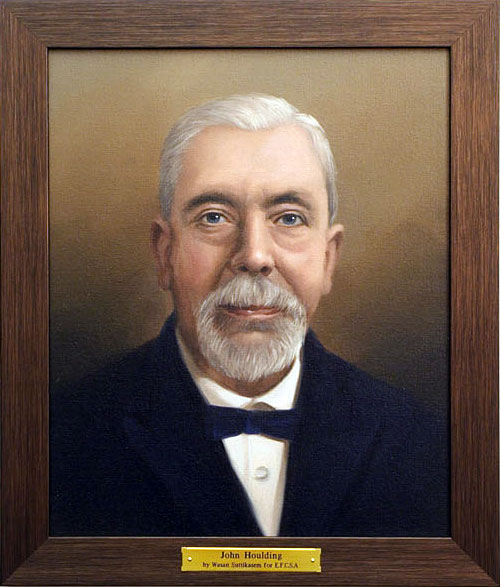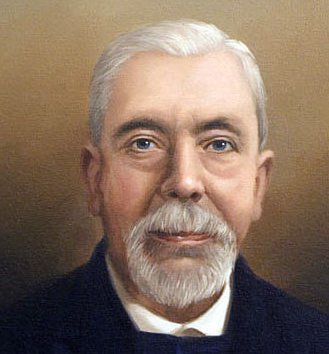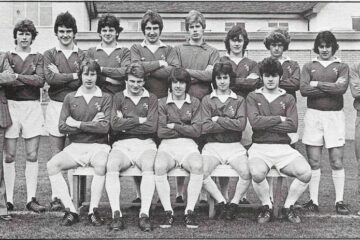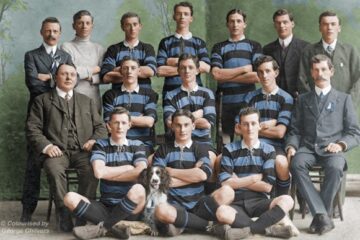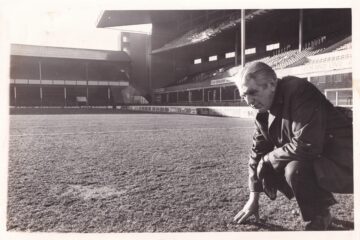This article is not intended either to praise or to condemn John Houlding for the role he played in the decision made by Everton Football Club to move away from Anfield. It is merely an effort to try and throw some light on this ‘larger than life character’ who played a big part in establishing the game of Association Football in his home town of Liverpool.
Local records reveal that John Houlding was baptised on 4 August 1833 at St Martin-in the-Field church. He was the second of three sons born to Thomas Houlding, a cow keeper, and his wife Alice. At this time, the family resided at 19 Tenderden Street where the income from Thomas Houlding’s occupation enabled him to provide his children with a good standard of education and a comfortable home in which to live.
The 1851 census reveals that John Houlding was still living in Tenderden Street where, along with his younger brother William, he listed his occupation as “auditing at home”. He then worked in several occupations before acquiring a job and accommodation at Davidson’s Brewery in 111-115 Soho Street, Liverpool. In 1856 he married Jane Lowe at St. Peter’s church on Sackville Street in Everton. The marriage certificate indicates that Jane was also residing in Soho Street and that she was a farmer’s daughter who had been born in Thornton.
The couple feature on the 1861 census living at 115 Soho Street, and John listed his occupation as brewery manager. They had one daughter, Alice. By 1871, the couple had set up home at 17 Robson Street with their three children. John Houlding had opened his own brewery at 34 Tynemouth Street, and owned several outlets in the Breckfield Road area of Liverpool. He had also expanded his social life by becoming the president of Everton Quoits Club.
This sport was once quite popular amongst residents of the Mersey seaport and several clubs were based in the inns and taverns on the outskirts of the area. The Everton Club were one of the leading organisations and played their home matches in the Grotto at the Cabbage Hall Tavern on Breck Road. The team was captained by Arthur Boylett, born 1843 in Everton, who lived at 122 Hamilton Road and ran his own plumbing business. He was a member of the local Conservative Party and is listed, along with John Houlding, amongst vestry records of St. Saviour’s church on Breckfield Road.
Houlding was also a prominent member of Everton Cricket Club which played home matches on Walton Breck Road. In his younger days, he had been a keen cricketer and played for the Breckfield Club. His involvement in the summer sport was confirmed by the following comments in the newspaper article that appeared when the Everton Club played hosts to the boys from the Bluecoat School in Liverpool:
The juvenile party were amply provided during their visit with substantial refreshments consisting of buns and milk, this department being efficiently superintended by Mr John Houlding. With rain setting in, the cricket match was not played out, but a variety of sports, including football and foot racers were entered into with great zest. (Liverpool Courier, 23 June 1871)
This report confirmed that some primitive form of football had now reached the shores of the Mersey and that John Lowe, the brother-in law of John Houlding, played cricket for the Everton Club. It was at this location that these two men would have possibly first become acquainted with John Clarke and Thomas Evans, both experienced cricketers,. The foundations of an Association Football Club were laid to keep them entertained through the dark days of winter. Houlding became the president of the football section and John Lowe deputised in his absence. The club established its headquarters at the Queens Head Tavern, before shifting to the Sandon Hotel.
This location is named in deference to the local Conservative MP Lord Sandon, who was about to be elevated to the House of Lords. The property, which was owned by Houlding, was home to the Everton Bowling Club. Arthur Boylett, and John Lowe were also prominent members of this organisation, as indicated by the minutes which stated that Mr. Houlding, president of the Bowls Club, had also been re-elected as president of Everton Football Club, while John Lowe continued to deputise in his absence.
The population of Liverpool, in the meantime, was increasing and the census released in 1881 revealed that it had now reached 552,000. Only London had a larger population. John Houlding listed his occupation as that of Building Contractor and Brewer, while residing at number 32 Anfield Road within the township of Walton-on-the-Hill. In 1884 he oversaw the re-settlement of the football club to a field near his home where, eventually, he became the landlord.
The 1891 census found that the Houlding family had moved to number 73 Anfield Road. Everton Football Club were about to defend their title as champions of the Football League. The campaign, however, would be overshadowed by a great deal of ‘off the field activity’ with regard to the £250 ground rent that the football club was now requested to pay Houlding. Meanwhile, Mr. Orrell, who owned the adjacent land, also wanted them to pay him £130 if they wished to extend the ground. For comparison, Aston Villa, the next highest paying tenants, were paying £175. This request caused some anxiety amongst the club membership and a EGM was called. Mr. William Barclay took the chair.
Mr Houlding was represented by John McKenna who was a recent acquisition to the Everton board. Born in the Irish County of Monaghan, he had come to Liverpool as a youth to work in the grocery shop that was run by his uncle, John McArdle, at 53 Stanley Road in Kirkdale. At the time of the meeting, he held the position as Vaccination Officer with the West Derby Board of Guardians.
Following a heated debate, Mr Barclay informed the dissidents that they were wasting time complaining because Mr Houlding would not settle for a penny less than the price he was asking for. George Mahon, seconded by James Griffiths, then moved that the club should de-camp to Goodison Road and the resolution was carried by large majority. A further resolution was then passed to instruct the solicitors to register the club and draw up the articles of association. John Houlding, however, did not want to relinquish the name of Everton.
Having been the president of Everton Cricket, Quoits and Bowls clubs, he was not going to give up the football section without a fight. He called a meeting of his followers and it was decided to form a new company that was to be called Everton Football Club and Athletic Grounds. Houlding then took the train to London and registered the new company at Somerset House before going on to Chancery Lane where he attempted to register his new club with the FA. His actions angered the vast majority of the Everton membership, who, after a series of meetings, finally gathered at a school hall in Liverpool and passed a motion of no confidence in Houlding and several other members of the board.
John Houlding, who made a surprise appearance, was allowed to address the gathering and attempted to justify his actions by suggesting that he wanted to extend the Anfield enclosure to include other sporting activities such as athletics and cycle racing. The home of the Aston Villa club had already developed along these lines. Bolton Wanderers and Blackburn Rovers were hoping to do the same. His words, however, fell on deaf ears and it soon became apparent that that his days as president of the Everton Football Club were swiftly coming to an end. The proposal to accept the lease on the land on Goodison Road was then put to the meeting and only eighteen people voted against it. The club then completed its list of Football League fixtures, which came to an end with the defeat of Accrington at Anfield. After that, the club departed the location.
John Houlding had now relinquished all rights to the name of Everton and decided to form Liverpool Football Club. The FA committee met 26 April 1892 in Liverpool, and the new name was added to their membership. The new club’s application to join the Football League was rejected. George Mahon, who was present at the meeting, then put forward the case for compensation with regards to Everton FC not being allowed to remove the stands and turnstiles from the Anfield ground and re-position them at Goodison Park. The FA committee refused permission to remove any item from what was now the home ground of the Liverpool FC, but ordered the new organisation to pay the sum of £250 in compensation. The matter was then brought at an end.
John Houlding now set about building a new football team to occupy the vacant enclosure at Anfield and his side began life playing football in the Lancashire League. Eventually, Mr. Houlding saw his team win the Football League championship in 1901, but, by then, his health was giving cause for concern. He took a trip to the south of France which he hoped would aid his convalescence. However, during the second week of March 1902, his condition became so serious that his two children, William and Alice, were summoned to his bedside. Alderman Houlding gradually sank, and died on the morning of 18 March in Nice. He was 70 years old. Tributes were paid to him in all the local newspapers when the sad news of his death reached Liverpool the next day:
Mr. W Stewart, who occupied the bench at the City Police Court, was reported as saying…that he was very much shocked to hear of news which had just reached him of the death of John Houlding. The shock was doubled from the fact that none of them knew he was seriously ill. He had always heard of him spoken of as “Honest John Houlding” and everyone who came in to contact with him found him to be honest to the backbone. It was a great loss to Liverpool, to which he devoted a very large portion of his life. (Liverpool Daily Post)
After severing his links with the Everton Club, Mr. Houlding had become a chief magistrate and in 1897-98 had occupied the office of Lord Mayor of Liverpool. During the last years of his life, he had practically retired from business and partly devoted his leisure to continental travel. In private life he was a diligent student – a lover of literature – and an unusually good French scholar. His death was received with great sadness in the Everton area of Liverpool. Thousands turned out to pay him their last respects.
Mr Houlding was no longer a parishioner of St. Saviour’s and had spent the final years of his life worshipping at the church of St. Simon and St. Jude. The building, consecrated in 1897, stood not 50 yards from his home on Anfield Road and it was here that his funeral service took place on Friday 21 March. The mourners were led by his two children and three grandchildren. The congregation included three Members of Parliament and many local Conservative councillors of Liverpool. The other main political parties were also well represented. Mr Houlding was also a Freemason and a member of the Orange Order and many members from these respective organisations were present to pay their last respects. Dr James C Baxter, along with Abraham J. Coates, attended the service on behalf of Everton Football Club for, despite their differences in the past, the two men had retained a healthy respect for each other.
Thousands of people lined the route when the cortege left church bound for Everton Cemetery in Fazackerley. Alderman John Houlding was laid to rest beside his wife Jane who had predeceased him by six years. The crowds then dispersed.
A most fitting epitaph, with which to end this article, was written by an unnamed journalist who worked for a Bolton-based sports paper:
The demise of John Houlding, the ex-mayor of Liverpool, will be a serious loss to Mersey football, and particularly to the present holders of the League title. Without his help that club would have been practical an impossibility. It is all very well to say that the man who refused to go with “rebelling” Evertonians would have had a club whether Mr. John Houlding had ever been with them or not, but the point is whether they would had ever been able to secure the team which took them to the head of the Lancashire League – which at the time – 10 years ago – was a veritable power – and then thrust them in to Division One from a lower chamber.
I know something of the circumstances, and have no hesitation in saying that the golden help which came from Mr. Houlding alone enabled them to get their men, and keep their ground, and “face the racket” until they finally established themselves. It might also be ventured that there have been moments since when only the same willingness to help has enabled the now famous reds to tide over the recurring tides of ill-fortune which have come upon them.
We may not all agree as to the certainty of Mr Houlding’s methods. We may differ in principle from what some have alleged was “behind the friendship”, but when he gets his due he stands forth as the man who made 1st class football possible in the city of shipping years earlier than would otherwise have been the case.
One of the issues raised during the quarrel which led to the separation of the Everton footballers has been settled on lines which at the time did not seem probable, but have made for the strengthening and betterment of the game. Time was when licensed premises were the only resort – or practically the only resort of our big clubs. Teams dressed in public houses, committees met there, players foregathered there for instruction and during training. Now our clubs keep far away from this sort of thing as they can and change in the best interest of all concerned. The association and the league have had much to do with the change and clubs must now have dressing rooms on the ground.
This was one the points at issue in Liverpool, 10 years ago, and the decision in this respect has done much to raise the tone of the game and lessen the temptation which environs it to the young. (Football Field, 22 March 1902).
Tony Onslow
